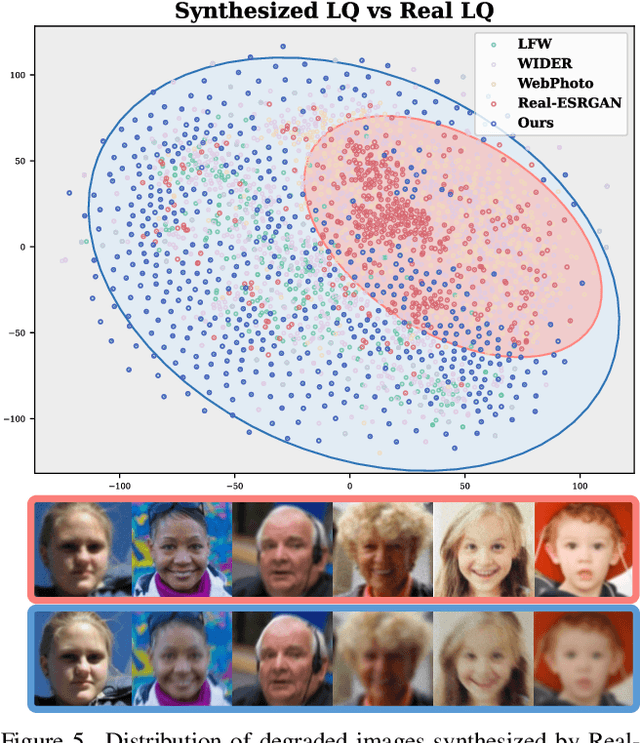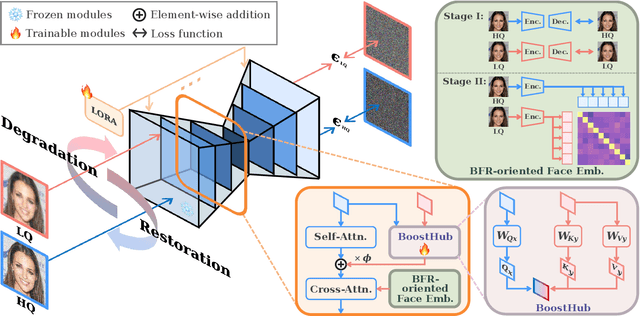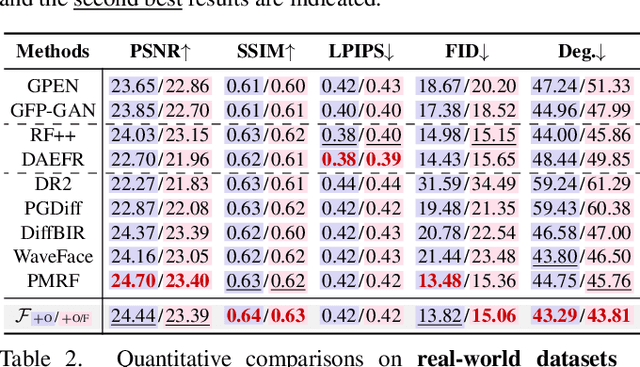Jungong Han
Point Linguist Model: Segment Any Object via Bridged Large 3D-Language Model
Sep 09, 2025Abstract:3D object segmentation with Large Language Models (LLMs) has become a prevailing paradigm due to its broad semantics, task flexibility, and strong generalization. However, this paradigm is hindered by representation misalignment: LLMs process high-level semantic tokens, whereas 3D point clouds convey only dense geometric structures. In prior methods, misalignment limits both input and output. At the input stage, dense point patches require heavy pre-alignment, weakening object-level semantics and confusing similar distractors. At the output stage, predictions depend only on dense features without explicit geometric cues, leading to a loss of fine-grained accuracy. To address these limitations, we present the Point Linguist Model (PLM), a general framework that bridges the representation gap between LLMs and dense 3D point clouds without requiring large-scale pre-alignment between 3D-text or 3D-images. Specifically, we introduce Object-centric Discriminative Representation (OcDR), which learns object-centric tokens that capture target semantics and scene relations under a hard negative-aware training objective. This mitigates the misalignment between LLM tokens and 3D points, enhances resilience to distractors, and facilitates semantic-level reasoning within LLMs. For accurate segmentation, we introduce the Geometric Reactivation Decoder (GRD), which predicts masks by combining OcDR tokens carrying LLM-inferred geometry with corresponding dense features, preserving comprehensive dense features throughout the pipeline. Extensive experiments show that PLM achieves significant improvements of +7.3 mIoU on ScanNetv2 and +6.0 mIoU on Multi3DRefer for 3D referring segmentation, with consistent gains across 7 benchmarks spanning 4 different tasks, demonstrating the effectiveness of comprehensive object-centric reasoning for robust 3D understanding.
Unlocking the Potential of Diffusion Priors in Blind Face Restoration
Aug 12, 2025



Abstract:Although diffusion prior is rising as a powerful solution for blind face restoration (BFR), the inherent gap between the vanilla diffusion model and BFR settings hinders its seamless adaptation. The gap mainly stems from the discrepancy between 1) high-quality (HQ) and low-quality (LQ) images and 2) synthesized and real-world images. The vanilla diffusion model is trained on images with no or less degradations, whereas BFR handles moderately to severely degraded images. Additionally, LQ images used for training are synthesized by a naive degradation model with limited degradation patterns, which fails to simulate complex and unknown degradations in real-world scenarios. In this work, we use a unified network FLIPNET that switches between two modes to resolve specific gaps. In Restoration mode, the model gradually integrates BFR-oriented features and face embeddings from LQ images to achieve authentic and faithful face restoration. In Degradation mode, the model synthesizes real-world like degraded images based on the knowledge learned from real-world degradation datasets. Extensive evaluations on benchmark datasets show that our model 1) outperforms previous diffusion prior based BFR methods in terms of authenticity and fidelity, and 2) outperforms the naive degradation model in modeling the real-world degradations.
Modality-Aware Feature Matching: A Comprehensive Review of Single- and Cross-Modality Techniques
Jul 30, 2025Abstract:Feature matching is a cornerstone task in computer vision, essential for applications such as image retrieval, stereo matching, 3D reconstruction, and SLAM. This survey comprehensively reviews modality-based feature matching, exploring traditional handcrafted methods and emphasizing contemporary deep learning approaches across various modalities, including RGB images, depth images, 3D point clouds, LiDAR scans, medical images, and vision-language interactions. Traditional methods, leveraging detectors like Harris corners and descriptors such as SIFT and ORB, demonstrate robustness under moderate intra-modality variations but struggle with significant modality gaps. Contemporary deep learning-based methods, exemplified by detector-free strategies like CNN-based SuperPoint and transformer-based LoFTR, substantially improve robustness and adaptability across modalities. We highlight modality-aware advancements, such as geometric and depth-specific descriptors for depth images, sparse and dense learning methods for 3D point clouds, attention-enhanced neural networks for LiDAR scans, and specialized solutions like the MIND descriptor for complex medical image matching. Cross-modal applications, particularly in medical image registration and vision-language tasks, underscore the evolution of feature matching to handle increasingly diverse data interactions.
DiscoVLA: Discrepancy Reduction in Vision, Language, and Alignment for Parameter-Efficient Video-Text Retrieval
Jun 10, 2025Abstract:The parameter-efficient adaptation of the image-text pretraining model CLIP for video-text retrieval is a prominent area of research. While CLIP is focused on image-level vision-language matching, video-text retrieval demands comprehensive understanding at the video level. Three key discrepancies emerge in the transfer from image-level to video-level: vision, language, and alignment. However, existing methods mainly focus on vision while neglecting language and alignment. In this paper, we propose Discrepancy Reduction in Vision, Language, and Alignment (DiscoVLA), which simultaneously mitigates all three discrepancies. Specifically, we introduce Image-Video Features Fusion to integrate image-level and video-level features, effectively tackling both vision and language discrepancies. Additionally, we generate pseudo image captions to learn fine-grained image-level alignment. To mitigate alignment discrepancies, we propose Image-to-Video Alignment Distillation, which leverages image-level alignment knowledge to enhance video-level alignment. Extensive experiments demonstrate the superiority of our DiscoVLA. In particular, on MSRVTT with CLIP (ViT-B/16), DiscoVLA outperforms previous methods by 1.5% in R@1, reaching a final score of 50.5% R@1. The code is available at https://github.com/LunarShen/DsicoVLA.
THU-Warwick Submission for EPIC-KITCHEN Challenge 2025: Semi-Supervised Video Object Segmentation
Jun 07, 2025Abstract:In this report, we describe our approach to egocentric video object segmentation. Our method combines large-scale visual pretraining from SAM2 with depth-based geometric cues to handle complex scenes and long-term tracking. By integrating these signals in a unified framework, we achieve strong segmentation performance. On the VISOR test set, our method reaches a J&F score of 90.1%.
Interpretable Few-Shot Image Classification via Prototypical Concept-Guided Mixture of LoRA Experts
Jun 05, 2025



Abstract:Self-Explainable Models (SEMs) rely on Prototypical Concept Learning (PCL) to enable their visual recognition processes more interpretable, but they often struggle in data-scarce settings where insufficient training samples lead to suboptimal performance.To address this limitation, we propose a Few-Shot Prototypical Concept Classification (FSPCC) framework that systematically mitigates two key challenges under low-data regimes: parametric imbalance and representation misalignment. Specifically, our approach leverages a Mixture of LoRA Experts (MoLE) for parameter-efficient adaptation, ensuring a balanced allocation of trainable parameters between the backbone and the PCL module.Meanwhile, cross-module concept guidance enforces tight alignment between the backbone's feature representations and the prototypical concept activation patterns.In addition, we incorporate a multi-level feature preservation strategy that fuses spatial and semantic cues across various layers, thereby enriching the learned representations and mitigating the challenges posed by limited data availability.Finally, to enhance interpretability and minimize concept overlap, we introduce a geometry-aware concept discrimination loss that enforces orthogonality among concepts, encouraging more disentangled and transparent decision boundaries.Experimental results on six popular benchmarks (CUB-200-2011, mini-ImageNet, CIFAR-FS, Stanford Cars, FGVC-Aircraft, and DTD) demonstrate that our approach consistently outperforms existing SEMs by a notable margin, with 4.2%-8.7% relative gains in 5-way 5-shot classification.These findings highlight the efficacy of coupling concept learning with few-shot adaptation to achieve both higher accuracy and clearer model interpretability, paving the way for more transparent visual recognition systems.
AdaTP: Attention-Debiased Token Pruning for Video Large Language Models
May 26, 2025Abstract:Video Large Language Models (Video LLMs) have achieved remarkable results in video understanding tasks. However, they often suffer from heavy computational overhead due to the large number of visual tokens generated from multiple video frames. Existing visual token compression methods often rely on attention scores from language models as guidance. However, these scores exhibit inherent biases: global bias reflects a tendency to focus on the two ends of the visual token sequence, while local bias leads to an over-concentration on the same spatial positions across different frames. To address the issue of attention bias, we propose $\textbf{A}$ttention-$\textbf{D}$ebi$\textbf{a}$sed $\textbf{T}$oken $\textbf{P}$runing for Video Large Language Models ($\textbf{AdaTP}$), a novel token pruning pipeline for Video LLMs. AdaTP integrates two dedicated debiasing modules into the pipeline, targeting global attention bias and local attention bias, respectively. Without the need for additional training, our method significantly reduces the computational overhead of Video LLMs while retaining the performance of vanilla models. Extensive evaluation shows that AdaTP achieves state-of-the-art performance in various commonly used video understanding benchmarks. In particular, on LLaVA-OneVision-7B, AdaTP maintains performance without degradation while using only up to $27.3\%$ FLOPs compared to the vanilla model. Our code will be released soon.
Rethinking Score Distilling Sampling for 3D Editing and Generation
May 03, 2025Abstract:Score Distillation Sampling (SDS) has emerged as a prominent method for text-to-3D generation by leveraging the strengths of 2D diffusion models. However, SDS is limited to generation tasks and lacks the capability to edit existing 3D assets. Conversely, variants of SDS that introduce editing capabilities often can not generate new 3D assets effectively. In this work, we observe that the processes of generation and editing within SDS and its variants have unified underlying gradient terms. Building on this insight, we propose Unified Distillation Sampling (UDS), a method that seamlessly integrates both the generation and editing of 3D assets. Essentially, UDS refines the gradient terms used in vanilla SDS methods, unifying them to support both tasks. Extensive experiments demonstrate that UDS not only outperforms baseline methods in generating 3D assets with richer details but also excels in editing tasks, thereby bridging the gap between 3D generation and editing. The code is available on: https://github.com/xingy038/UDS.
From Gaze to Insight: Bridging Human Visual Attention and Vision Language Model Explanation for Weakly-Supervised Medical Image Segmentation
Apr 15, 2025Abstract:Medical image segmentation remains challenging due to the high cost of pixel-level annotations for training. In the context of weak supervision, clinician gaze data captures regions of diagnostic interest; however, its sparsity limits its use for segmentation. In contrast, vision-language models (VLMs) provide semantic context through textual descriptions but lack the explanation precision required. Recognizing that neither source alone suffices, we propose a teacher-student framework that integrates both gaze and language supervision, leveraging their complementary strengths. Our key insight is that gaze data indicates where clinicians focus during diagnosis, while VLMs explain why those regions are significant. To implement this, the teacher model first learns from gaze points enhanced by VLM-generated descriptions of lesion morphology, establishing a foundation for guiding the student model. The teacher then directs the student through three strategies: (1) Multi-scale feature alignment to fuse visual cues with textual semantics; (2) Confidence-weighted consistency constraints to focus on reliable predictions; (3) Adaptive masking to limit error propagation in uncertain areas. Experiments on the Kvasir-SEG, NCI-ISBI, and ISIC datasets show that our method achieves Dice scores of 80.78%, 80.53%, and 84.22%, respectively-improving 3-5% over gaze baselines without increasing the annotation burden. By preserving correlations among predictions, gaze data, and lesion descriptions, our framework also maintains clinical interpretability. This work illustrates how integrating human visual attention with AI-generated semantic context can effectively overcome the limitations of individual weak supervision signals, thereby advancing the development of deployable, annotation-efficient medical AI systems. Code is available at: https://github.com/jingkunchen/FGI.git.
iEBAKER: Improved Remote Sensing Image-Text Retrieval Framework via Eliminate Before Align and Keyword Explicit Reasoning
Apr 08, 2025



Abstract:Recent studies focus on the Remote Sensing Image-Text Retrieval (RSITR), which aims at searching for the corresponding targets based on the given query. Among these efforts, the application of Foundation Models (FMs), such as CLIP, to the domain of remote sensing has yielded encouraging outcomes. However, existing FM based methodologies neglect the negative impact of weakly correlated sample pairs and fail to account for the key distinctions among remote sensing texts, leading to biased and superficial exploration of sample pairs. To address these challenges, we propose an approach named iEBAKER (an Improved Eliminate Before Align strategy with Keyword Explicit Reasoning framework) for RSITR. Specifically, we propose an innovative Eliminate Before Align (EBA) strategy to filter out the weakly correlated sample pairs, thereby mitigating their deviations from optimal embedding space during alignment.Further, two specific schemes are introduced from the perspective of whether local similarity and global similarity affect each other. On this basis, we introduce an alternative Sort After Reversed Retrieval (SAR) strategy, aims at optimizing the similarity matrix via reverse retrieval. Additionally, we incorporate a Keyword Explicit Reasoning (KER) module to facilitate the beneficial impact of subtle key concept distinctions. Without bells and whistles, our approach enables a direct transition from FM to RSITR task, eliminating the need for additional pretraining on remote sensing data. Extensive experiments conducted on three popular benchmark datasets demonstrate that our proposed iEBAKER method surpasses the state-of-the-art models while requiring less training data. Our source code will be released at https://github.com/zhangy0822/iEBAKER.
 Add to Chrome
Add to Chrome Add to Firefox
Add to Firefox Add to Edge
Add to Edge